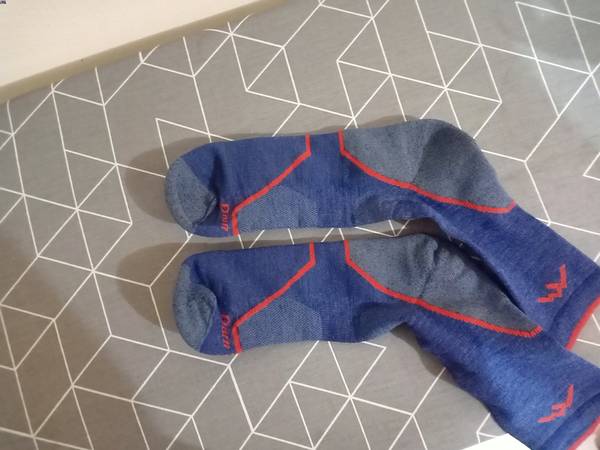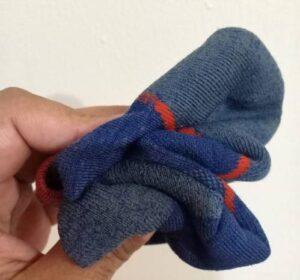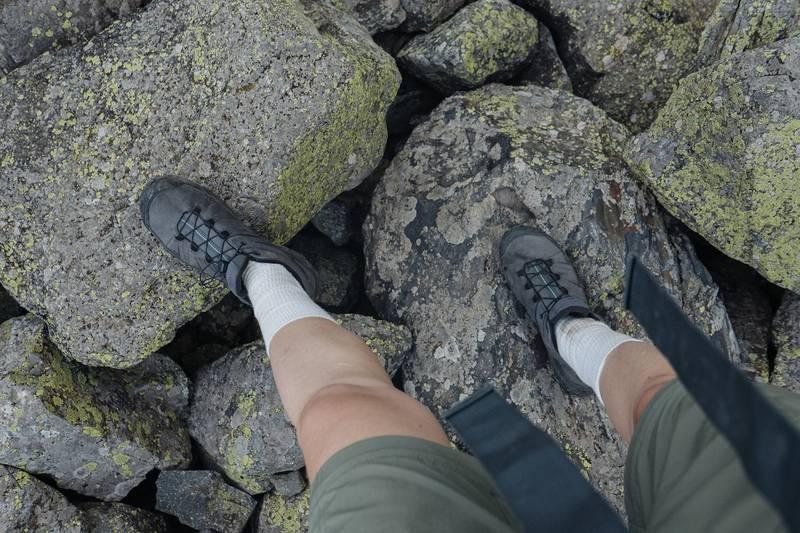We all thought socks were just an add-on, the hiking community will tell you otherwise. Once your feet start to explore an uncharted territory, even a stray thread inside your hiking boot can halt your progress.
If you have a hiking trip planned, it’s safe to say that packing the funky socks in which you slide around on your wooden floors will send you home in the first quarter of your trip.
This article will help you choose this accessory according to the need of the hour. Not only will you be packing for comfort but for getting all the technical details your never knew existed.
What are Hiking Socks?
Like everything else in your backpack, hiking socks are also designed to make you get the most out of your trekking.
Not only do they provide the comfort, but they are manufactured with constituents that are sturdy, provide stability and work with your boots to give your feet a breathable, moisture-controlled movement.
Mostly made of wool, hiking socks are made to provide insulation against the weather conditions.
Instead of absorbing the moisture, they wick away the moisture from your feet, in order to provide a no-slip surface to your foot. Hiking socks are made to cushion to your feet against shoe abrasions.
What Makes Hiking Socks Different than Regular Socks?
Regular socks are usually made of cotton and accessorize your everyday footwear. The cotton seldom helps in protection, stability or cushioning.
If you were to wear your hiking boots with regular socks, your feet will be more susceptible to blistering, sweaty and should they get wet, the absorption would cause you to halt entirely for a change of pair.

On the contrary, hiking socks compliment the resilience of your hiking boots. The next-to-skin knitting pattern of the yarn fits snuggly around your feet, resisting shoe-abrasion and usually a single pair can last longer than your regular cotton socks.
Benefits of Wearing Hiking Socks
Hiking socks can complete your gear once you have a trip planned. Be it a rocky terrain or a picturesque landscape, hiking socks will weather the thick and thin with you.
Regulate The Temperature of The Shoe
Hiking socks are often made of wool with a blend of materials such as polyester, nylon or polypropylene.
In addition to that, the majority of the sock industry is making use of Merino wool which creates a static-free, itch-free, antimicrobial and moisture-controlled environment for your feet.
Merino Wool has great wicking properties, which in turn makes it breathable. Once moisture enters the hiking sock, the absorption works as an insulation.
The water molecules store heat in the woollen sock and quickly evaporate when exposed to air. This distinction of hiking socks really helps in cold weather, where conservation of energy is required for trekking instead of regulating body temperatures.
Hiking Socks Vary in Thickness
Consider keeping cotton socks in your backpack because they are lightweight. While cotton gives you comfort and style in day-to-day life, it is ill-recommended for outdoor exertion.
Once cotton gets wet, it loses its shape, the microfibers mat almost immediately resulting in poor ventilation.
Not only will you have a very wet pair of cotton socks on your hands, but the drying out time will make you lag behind significantly.
Keeping in view the lightweight backpacking community, the hiking socks also come in a thin variety along with a thick one.
While you backpack in summer conditions, thin socks will keep you cool and wick the sweat away from your feet. While in cold condition, a thick pair of hiking socks will retain heat, provide comfort and keep your foot balanced within the shoe.
Hiking Socks Cushion Your Step
Cushioning your steps is as important for a rugged terrain as it is for an easy-to moderate trekking trail. Your feet and ankles take the brunt of the shock your walking, and your footwear helps in regulating shock absorption.

Hiking socks have an added feature of cushioning your jog, they are snug around the heel and the ball of your foot, providing you comfort during extreme-exertion.
Together with the hiking boots, hiking socks provide lucrative biomechanics for mountaineering and traversing through rough terrain.
However, thin hiking socks provide a light to medium cushioning for a summer hike, they regulate the temperature within the boot and eliminate the chances of overheating in warm conditions.
Offer Compression Panelling
One of the most advantageous structural efficiencies of hiking socks is the compression panelling it provides around the heel.
The next-to-skin knitting of the sock moulds itself around your heel eliminating the risk of bunching of fabric.
Most hiking socks have a seamless design which prevents chafing and hotspots while you experience an inclined trek.
To check if the compression panelling is in action, you have to make sure the sock is your size. A sock that is exactly your size will have its heel cup fit neatly onto your heel.
Cons of Wearing Hiking Socks
Your hiking socks might be your toughest armour, but every armour has a chink! Here are some cons to wearing hiking socks.
Reduced Friction
Due to the bulk of a hiking sock, the slipping and sliding factor is greatly enhanced. Even though Merino wool is a great option, its anti-static properties don’t allow the fibre of the sock to bond with the inner of the shoe, creating a smooth surface.
The reduced friction makes your feet slip and slide within your shoe, causing discomfort, sores and blisters.
While most hiking shoes have a range of 30-80% wool constituents, a sock sporting a blend of synthetic yarn fibre is always a good alternative to traditional woollen hiking sock.
Increased Drying Time
A hiking sock is can prove to be a troublesome accessory when it gets wet. Wool takes longer than cotton to dry out, even though it might not seem wet to the touch.
Due to its high absorption quality, wool is quick to store water and takes it time to let it evaporate.
In wet conditions, the drying out time might seem extremely inconvenient and put a halt to your progress.
Limited Flexibility
Hiking socks are a priority for mountaineers and hikers that trace rugged terrain. In sub-zero temperatures, layering of hiking socks proves to limit flexibility required to step forward on an inclined plane.
The seamless form of the hiking sock contours the foot, leaving it in a brace-like structure. Lining the hiking sock with a synthetic fibre yarn proves more conducive to the exercise.
How to Choose Hiking Socks
Choosing hiking socks may seem like rocket science right now but asking yourself these standard questions can help you figure out a great system for your hike.
Is It Going To Be Cold?
Before you choose a sock, figure out the kind of trail you will be taking. Your research in this regard might take you a long way in choosing your gear.
If you have decided on a cold, mountainous region where snow, slush and rain abound; a thick, ankle length sock made of pure merino wool will serve your purpose best.
These socks will compliment your heavy, hiking boots, save you from freezing, support your ankles and provide great cushioning to the soles of your feet.
The merino wool will provide you optimum breathability when they are paired with a waterproof hiking boot. They will wick the moisture off your feet and clamminess will be the thing of the past.
Is Waterproofing Not an Option?
If you are traversing a humid terrain and want your shoes to dry out quickly, you will do much better with a sock that sports synthetics such as Coolmax.
The synthetic fibre has high wicking properties and allows great ventilation within the shoe. It provides enough cushioning for a summer hike, doesn’t insulate your feet like a woollen sock and works well with the breathability of the hiking boots.
Are You a Lightweight Backpacker?
If you are a backpacker and carry your home on your back, you need socks that have heavy cushioning properties. Your feet will not only be carrying your weight but the weight of your backpack as well.
So, get socks that collaborate with your shoe in shock absorption while you hike. The best way to know the cushioning is calibrating the support your socks give to the heel of your foot.
If you are lightweight backpacker and are averse to carrying a few too many pairs of woollen socks, a silk or polypropylene liner is a good alternative.
You can always layer them with your single pair of hiking socks, which increase insulation and wicking, retaining warmth in colder regions.
Is Sock Height Necessary?
Sock height is necessary to prevent shoe abrasion, shoe-cuff scraping and toe to heel fit of the sock. If you are wearing a low-cut boot, a ‘No-show’ or ‘Ankle’ sock will match your style and comfort.
While no-show sock lengths are great with hiking sandals and moccasins, they can only be used for light hiking.
On the other hand, ankle length socks have an added feature of protection. However, neither of these lengths provide cushioning for a rigorous hike.
The most appropriate length for a hike is a ‘crew’. These socks cover a few inches above your ankle, providing optimum cushioning, maximum protection against shoe-cuff scraping and enough warmth on cold weather condition.
The ‘knee-high’ length is best for mountaineering and rugged terrain. This is the least varied category which requires an alpine trek for you to enjoy its features.
Its merino wool an itch-free environment to your feet, resisting microbial growth and providing a heavy cushion to help you tread forward.
Does Compression Panelling Help?
Your socks should contour the shape of your feet. The arches of your feet should have a snug fitting, the heel of your foot should slip right into the heel of your boot without having extra fibre bunching under around the bottom of your feet.
The compression panelling in hiking socks really hugs the shape of your feet. If you have an optimized pair according to the measurements of the company, your heel should fit into the seamless cup of your sock. The panelling will make your shoe fit perfectly without causing blisters and sores.
FAQs
Should you wear socks while hiking?
Hiking without socks is only manageable if you are a barefoot hiker. Socks provide your feet protection, support and extreme comfort.
Your feet have to do a lot of work while you hike, they have to balance you on inclination while keeping your center of gravity steady. For your feet to acquire such a feat, their comfort has to be your top-most priority.
Thus, wearing socks during a hike is imperative. It keeps your feet from slipping and getting injured. They provide added warmth and wick away moisture that would otherwise collect and make a breeding ground for bacteria.
Are hiking socks thin or thick?
Hiking socks come in both thick and thin material. Depending on the climatic conditions of your trail, you can choose between a pure wool sock or a wool and synthetic material blend.
If your range is rugged and has cold, harsh climatic weather; you need a pure wool sock that is thick and weathers the storm with you. Pure wool provides heavy cushioning and retains heat to save you from cold.
Contrarily, a summer trail requires a sock that has less than 30% wool and a high synthetic fibre content. Fibres such as Coolmax, provide durability and extended periods of ventilation while preventing overheating.
Can I wear normal socks with hiking boots?
Regular socks may provide you comfort during a short-distance running trail, they are inappropriate for a hike. Most regular socks are made of cotton which provides no cushioning, zero stability and doesn’t provide temperature regulation.
When cotton gets wet, its fibres lose their shape, mat together and lose their quality to ventilate. They have a long drying out period which makes them a burden to carry.
During a hike, the breathability of a sock guarantees wicking and water-proofing. Cotton lacks that quality and makes it impossible to allow water evaporation.
Are expensive hiking socks worth it?
Hiking socks should be a priority while gearing up for a trek. Most hiking socks are budget friendly, while the expensive ones are mostly used by mountaineers on a rugged terrain.
However, if you have invested in expensive hiking socks, its worth it to try them out in the cold weather instead of the three seasons.
What type of socks should you wear hiking?
While on a hike, wearing hiking socks are the best option. Coupled with hiking boots, hiking socks create a smooth trailing experience. While hiking you require ankle support, clean and dry feet and great ventilation in case your feet get wet.
Hiking socks provide all these features while keeping your feet from getting clammy and breaking into blisters.
Their woollen constituents help to retain body warmth on a cold trek and a cooling effect on a hot hiking trail. They absorb great quantities of water molecules and release them once expose to air.
What is the difference between running socks and hiking socks?
Running socks provide great flexibility so you can shape your feet according to your strike rate. They have no cushioning and do not provide the ankle support hiking socks can give.
Running socks have a different fit to a hiking sock, which sports compression panelling to fit snugly within a hiking boot.
While a running sock is thinner than a hiking sock, it provides great temperature regulation during a high-impact exercise. It is designed to be more breathable to keep the sweat from collecting within the shoe and causing a slip and slide movement.
Should you wear cotton socks hiking?
Cotton socks can provide you with style but not with support. For an outdoor exercise which demands rigorous performance, cotton is a poor choice.
Cotton has no insulating properties which means it can not retain body heat. The precious energy needed for hiking will be wasted in keeping your feet warm.
Cotton takes a lot of time to dry, thus if your cotton sock has gotten wet on a cold hike, you might be running a risk of gangrene or frostbite.
In hot climatic hikes, the sweat mats the fibre of the cotton and since the breathability is reduced, your feet will be swimming in a pool of sweat.
What kind of socks to wear hiking in summer?
Summer hiking requires a sock that has high breathability, maximum ventilation and a quick drying out time. The best option for such a hike is a blend of wool and some synthetic fibre such as nylon or polyester.
The synthetic yarn of these socks provides durability, more breathability than a pure woollen sock and absorbs less water content if it gets wet.
The drying out time of such socks are incredibly low and wicking is great, they still provide more cushion than a regular sock.
Our Verdict: Do hiking socks make a difference?
Hiking socks make a great difference to the quality of your hiking experience. Once your feet are cushioned, they are less tired making you stick to a schedule. Your feet aren’t sweat slicked, the antimicrobial qualities of wool also promise a decreased risk of bacterial overgrowth.
Hiking socks can help you bid adieu to chafing, sore, blisters and long stays to dry your only pair while you are freezing your toes off. In summer, hiking socks keep your feet cool and dry, which is more than one can ask for.
